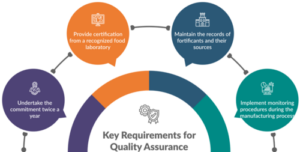Table of Content
Food Fortification as per Food Safety and Standards (Fortification of Food) Regulation, 2018
%20Regulation%2C%202018%20500.png)
Overview
The Food Safety and Standards (Fortification of Food) Regulation, 2018, in India aims to enhance the nutritional value of commonly consumed foods by adding essential nutrients to combat deficiencies. It establishes guidelines for nutrient specifications, labelling, and safety standards, promoting public health while ensuring compliance and quality control.
Short Summary
- The Food Safety and Standards (Fortification of Food) Regulation, 2018, aims to improve public health by fortifying food commodities with essential nutrients to address nutritional deficiencies.
- Specific guidelines are provided for nutrient specifications, labelling, and safety to ensure quality and consumer awareness.
- The Food Safety and Standards Authority of India oversees compliance and monitoring of food standards to maintain safety and effectiveness in food fortification.
Introduction
Fortification involves intentionally enhancing the levels of certain micronutrients (such as vitamins and minerals) in foods commodities to boost their nutritional value, meet their recommended intake levels, and improve health. The Food Authority authorises the fortification of staple foods at the direction of the Government of India.
In addition to compensate nutrients lost during the processing of staple foods, adding micronutrients can also help improve the nutritional profile of these food commodities.

Fig. 1: Fortification of Foods and Condiments
General Principles for Fortification
Only non-heme iron sources should be used for fortification in food products. Fortified processed foods can be created from fortified cereals and/or milk. They should provide 15-30% of the recommended daily allowance (RDA) for adults, based on an average intake of 600 calories from processed foods.
Moreover, foods that are high in fat, sugar, or salt (HFSS) cannot be classified as fortified processed foods, in accordance with the existing regulations.
Quality Assurance Requirements
Every manufacturer and packer of fortified food is required to provide a commitment to quality assurance and submit evidence of compliance to the designated Food Authority. This ensures that the food meets the established safety and quality standards.
Manufacturers shall give the undertaking twice a year. The undertaking shall include certification from a FSSAI-recognized food laboratory that verifies compliance with legal standards, maintaining up-to-date records of fortificants and their sources, and implementing monitoring procedures during the manufacturing process.

Fig. 2: Key Requirements for Quality Assurance
Additionally, manufacturers are responsible for conducting random tests on both fortificants and fortified food, performing regular audits of technical equipment and processes, and adhering to good manufacturing practices as specified by the Food Authority.
They should also reference purity criteria from established pharmacopoeias and guidelines from international organisations as specified by the FSSAI.
Finally, all fortified food must comply with relevant laws and regulations throughout its production, labelling, handling, and distribution, whether it is voluntarily fortified or required to meet mandatory standards.
Standards for Fortification of Foods
The Food Safety and Standards (Fortification of Food) Regulation, 2018, provides a framework for the fortification of food in order to enhance its nutritional value. Here are the key standards and guidelines outlined in this regulation:
| Product | Component for fortification | Source of nutrients |
| Double Fortified Salt (Iron-Fortified Iodized Salt) | Iodine (15-30 parts per million)
Iron (850-1100 parts per million) |
Potassium Iodate
Ferrous Sulphate or Ferrous Fumarate |
| Fortified Oil | Vitamin A (6-9.9 µg RE per gram of oil)
Vitamin D (0.11-0.16 µg per gram of oil) |
Retinyl Acetate or Retinyl Palmitate
Cholecalciferol or Ergocalciferol
|
| Fortified Milk | Vitamin A (270-450 µg RE)
Vitamin D (5-7.5 µg) |
Retinyl Acetate or Retinyl Palmitate
Cholecalciferol or Ergocalciferol (only from plant source)
|
| Fortified Atta | Iron (28-42.5 mg per kg)
or Sodium Iron (III) Ethylene Diamine Tetra Acetate Trihydrate (14‑21.25 mg) Folic Acid (75-125 µg per kg) Vitamin B12 (0.75-1.25 µg) |
Ferrous citrate or Ferrous lactate or Ferrous sulphate or Ferric pyrophosphate or electrolytic iron or Ferrous fumarate or Ferrous BisGlycinate
Folic Acid Cyanocobalamin or Hydroxycobalamine |
| Fortified Maida | Iron (28-42.5 mg per kg)
Or
Sodium Iron (III) Ethylene Diamine Tetra Acetate Trihydrate (14‑21.25 mg) Folic acid (75-125 µg) Vitamin B12 (0.75-1.25 µg) |
Ferrous Fumarate or Ferrous BisGlycinate or Ferrous Citrate or Ferrous Lactate or Ferrous Sulphate or Ferric Pyrophosphate or Electrolytic Iron
Cyanocobalamine or Hydroxycobalamine |
| Fortified Rice | Iron (28-42.5 mg)
or Sodium Iron (III) Ethylene diamine tetra Acetate Trihydrate (14‑21.25 mg) Folic acid (75-125 µg) Vitamin B12 (0.75-1.25 µg) |
Ferric Pyrophosphate
Folic Acid Cyanocobalamine or Hydroxycobalamine |
By ensuring compliance with these regulations, stakeholders can effectively address nutrient deficiencies and promote overall well-being in the population.
Conclusion
The Food Safety and Standards (Fortification of Foods) Regulations, 2018, represent a significant step toward improving public health through enhanced nutritional standards.
By mandating the fortification of staple foods with essential vitamins and minerals, these regulations aim to address widespread deficiencies and promote overall wellness.
They establish clear guidelines for the types and levels of nutrients to be added, ensuring safety and efficacy while facilitating consumer awareness through labelling requirements. Ultimately, these regulations not only support the nutritional needs of the population but also contribute to reducing health disparities and enhancing food security.
Continued monitoring and adaptation will be essential to maximise their impact and respond to emerging nutritional challenges.
References
- Food fortification [Internet]. World Health Organization; 2022.
Available from: https://www.who.int/health-topics/food-fortification#tab=tab_1 - Food Safety and Standards (Fortification of Foods) Regulations, 2018 [Internet].
Available from: https://www.fssai.gov.in/upload/uploadfiles/files/Compendium_Food_Fortification_Regulations_05_06_2022.pdf
Enquire Now
To enquire about our services please complete the form below and we will be in tough with you as soon as possible
Food Regulatory Services
- Consumer Product
- Compliance Services
- Licenses